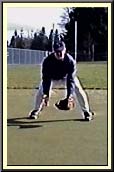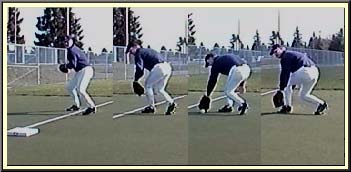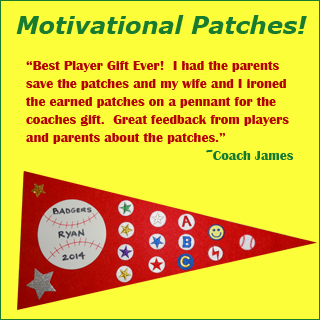Playing Third Base
Reflexes
As a third baseman, you won't need the quickness of a shortstop or a second baseman, but still must have quick reflexes. The ball often is hit very hard toward third base and the lack of distance doesn't give you much time to react. In addition to quick reflexes, you need lots of courage and toughness. When a hard hit ball comes to third, you often only has time to knock the ball down… with your body.
Ready Position
 Since the ball can be on top of you so quickly, it's important to position yourself a little lower to the ground than the shortstop or second baseman needs to. You must have your glove lower as well. Be ready for the hot shot hit right at your feet. Remember it's easier and quicker to bring your glove up than it is to drop it down.
Since the ball can be on top of you so quickly, it's important to position yourself a little lower to the ground than the shortstop or second baseman needs to. You must have your glove lower as well. Be ready for the hot shot hit right at your feet. Remember it's easier and quicker to bring your glove up than it is to drop it down.
Movement
Fielders at other positions often have the time to round the ball and play it in front of them. For the most part, the third baseman doesn't have this luxury. At third base you must be able to cross over quickly and get to the ball hit to either side. Work very hard on your lateral movement and fielding ground balls, both backhanded and to your glove hand side.
Backhand Play

The backhand play down the third base line is one of the most difficult plays in baseball to make. Even if you just manage to knock the ball down, you certainly can turn a double into a single. When making a backhanded play a ball hit to your right, make sure you keep your glove in front of your face. Watch the ball all the way into the glove and try and catch it in the webbing. On a backhand, if the ball hits the palm of your glove, it can pop out since you don't have the benefit of using your throwing hand while fielding.
You can field the ball with your left foot in front, your right foot in front, or while diving. No matter how you field the ball, position yourself to make a good throw after the play. Once you have caught the ball take a step or two to slow yourself down and then plant your right foot. Once you have planted, take a shuffle step toward first and make a strong throw. Make sure you throw the ball overhand with good 12-6 rotation. Throwing the ball sidearm causes the ball to tail and can make it difficult for the first baseman to catch it.
Slow Roller
Whether a bunted ball or chopped ball on a full swing, the slow roller is one of the most difficult defensive plays in baseball. This ball can be fielded one handed or two handed, as determined by the speed of the ball and the speed of the runner. No matter how you end up fielding the ball, charge the ball hard and then break down with short steps for proper timing, prior to fielding the ball.
If you have time, the surest way to field the ball is two handed. The next best method of fielding the ball is catching it on your glove hand side while running. You should time it to catch the ball with your left foot planted and your glove out in front. Once you have fielded the ball, quickly transfer the ball and make a throw to first. The final method of fielding the slow roller is to use your bare hand. It's essential that you watch the ball all the way into your hand. Don't pick up your head prior to fielding the ball and leave the ball on the ground.
No matter how you field the ball, make sure you are balanced. Without balance, it is difficult not only to make the catch, but to make the difficult throw to first. Practice fielding the slow roller using all the methods described above. It's a difficult play and as a third baseman, it's one you have many opportunities to make over the course of a season.
Most Recent Blog Posts
Working With Players on Focusing on the Correct Part of the Baseball when Hitting (October 15 2016)
Getting More Accurate Throws From Your Team (April 5 2016)
Thanks for all the great information and drills! I've used the site all season and it's made my life so much easier.
- Jim N.







